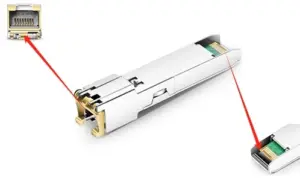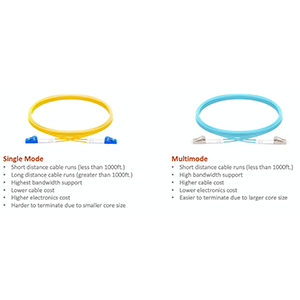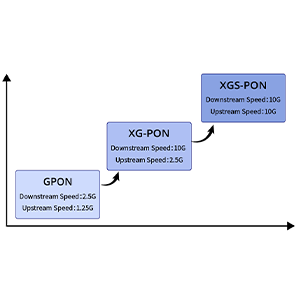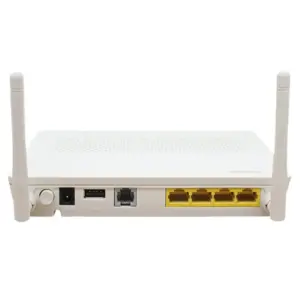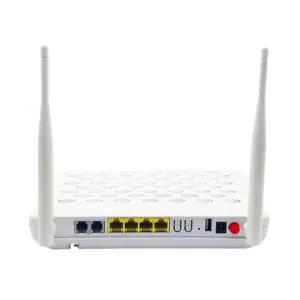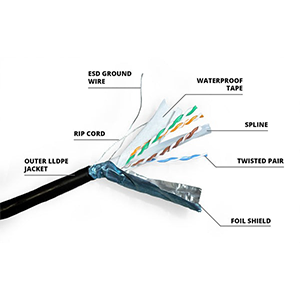In this article, I will delve into SFP optical modules, a key fiber transmission device. We will introduce the definition, functions and application areas of SFP optical modules to help you understand its importance and value in different industries. Let us explore the wonderful world of SFP optical modules together!
Basic overview of SFP optical modules
SFP optical module (Small Form-factor Pluggable) is a small, pluggable optical module used to implement optical fiber communications. It is a standardized optical module package that is usually used in network equipment, such as switches, routers, and servers.
The main features of SFP optical modules are their miniaturization and interchangeability. It adopts a compact package, making it relatively small and easy to install and replace. At the same time, the SFP optical module has hot-swappable characteristics and can be inserted or unplugged during operation without shutting down the device or interrupting the network connection.
- The basic structure of the SFP optical module includes the following main components:
-
Optical Transceiver: The SFP optical module contains a photoelectric converter, which is used to convert electrical signals into optical signals (optical transmitting function) or convert optical signals into electrical signals (optical receiving function). . This conversion is achieved through optical fibers and optical components such as lasers and photodetectors.
-
Connection interface: SFP optical modules usually have metal pins and fiber optic connections. Metal pins are used to make an electrical connection to a device’s socket or connector to provide power and signal transmission. The optical fiber connection port is used for optical connection with the optical fiber, so that the optical signal can be transmitted in the optical fiber.
- The working principle of the SFP optical module is as follows:
-
Light emission function: When an electrical signal is received, the laser in the SFP optical module converts the electrical signal into an optical signal. The optical signal generated by the laser is shaped and modulated by appropriate optical components and then sent through optical fiber to the target device or fiber-optic network.
-
Light receiving function: When receiving a light signal, the light detector in the SFP optical module converts the light signal into an electrical signal. The optical signal is demodulated and shaped by optical components and then converted into corresponding electrical signals for processing and decoding by the target device.
SFP optical modules have certain standardization in design to ensure compatibility and interoperability. It follows the SFP Multi-Source Agreement (MSA) standard, allowing SFP optical modules produced by different suppliers to be used interchangeably in a variety of compatible devices.
In short, the SFP optical module is a small, pluggable optical module that converts electrical signals and optical signals through a photoelectric converter. Its compact packaging and standardized interface make it widely used in network equipment.
Types and applications of SFP optical modules
There are many types of SFP optical modules (Small Form-factor Pluggable), each type has different characteristics in terms of transmission rate, protocol support and application fields. The following are common SFP optical module types and their use in different application fields:
-
SFP (SFP1G): The most basic type of SFP optical module, supporting a transmission rate of 1.25 Gbps. It is typically used for short-distance communications such as data transmission in local area networks (LANs) and corporate networks.
-
SFP+: SFP+ is an upgraded version of SFP optical module, supporting higher transmission rates, up to 10 Gbps. It is widely used in data centers, enterprise networks, storage networks and other fields for high-speed data transmission and connection to servers, storage devices and network devices.
-
QSFP (Quad Small Form-factor Pluggable): QSFP optical module is a higher-speed optical module that supports four channels of parallel transmission, and the transmission rate of each channel can reach 10 Gbps. It is widely used in data centers, cloud computing and high-performance computing fields for high-density data transmission and connecting equipment such as high-speed switches, servers and routers.
-
QSFP+: QSFP+ is an upgraded version of the QSFP optical module, supporting higher transmission rates, up to 40 Gbps. It is widely used in data centers and high-performance computing for high-speed data transmission, network aggregation, and optical communications.
Different types of SFP optical modules play important roles in different application fields:
-
Data center: Data centers usually require high-speed, high-bandwidth data transmission and connections, so SFP+ and QSFP+ optical modules are often used. They are used for high-speed connections between servers, upstream connections to network switches and routers, and connections to storage devices.
-
Telecommunications: In the field of telecommunications, SFP optical modules are widely used in transmission equipment, optical fiber access equipment and transmission networks. SFP and SFP+ optical modules are used for optical fiber transmission in fiber access networks (FTTx) and optical transport networks. QSFP and QSFP+ optical modules are used for high-speed transmission and optical communications.
-
Enterprise Network: In enterprise networks, SFP and SFP+ optical modules are often used to connect local area networks (LAN) and wide area networks (WAN) between switches, routers and servers. They provide high-speed, reliable data transmission and support multiple protocols such as Ethernet, Fiber Channel, and SONET/SDH.
It should be noted that with the development of technology, new SFP optical module types may continue to appear to meet the growing transmission needs. When selecting a suitable SFP optical module type, comprehensive considerations should be made based on specific application requirements, transmission distance, budget and other factors, and the advice of the optical fiber supplier or professional engineer should be consulted.
Transmission rate and distance of SFP optical module
SFP optical module (Small Form-factor Pluggable) supports multiple transmission rates, and different rates correspond to different data transmission requirements. The following are common SFP optical module transmission rates and their characteristics:
-
1Gbps (SFP1G): The 1Gbps transmission rate SFP optical module is suitable for shorter distance data transmission, such as data communication in local area networks (LAN) and enterprise networks. Multimode fiber is usually used for transmission.
-
10Gbps (SFP+): The SFP+ optical module with 10Gbps transmission rate supports higher-speed data transmission and is widely used in data centers, enterprise networks, storage networks and other fields. It can be transmitted using multimode fiber or single-mode fiber, and the transmission distance depends on the type of fiber selected.
-
40Gbps (QSFP+): QSFP+ optical module with 40Gbps transmission rate is used for high-density data transmission and optical communications. It can be transmitted using multimode fiber or single-mode fiber, and the transmission distance also depends on the type of fiber selected.
-
100Gbps (QSFP28): The QSFP28 optical module with a transmission rate of 100Gbps is suitable for high-speed data transmission and network aggregation. It usually uses single-mode fiber for transmission, and the transmission distance is also limited by the fiber type.
For SFP optical modules with different transmission rates, the maximum transmission distance and fiber type requirements supported are as follows:
-
1Gbps: For 1Gbps SFP optical module, when using multi-mode fiber, the maximum transmission distance is usually 550 meters (OM2 fiber) or 1000 meters (OM3/OM4 fiber). When using single-mode fiber, the maximum transmission distance can reach more than 10 kilometers.
-
10Gbps: For 10Gbps SFP+ optical modules, when using multi-mode fiber, the maximum transmission distance is usually 300 meters (OM3 fiber) or 400 meters (OM4 fiber). When using single-mode fiber, the maximum transmission distance can reach more than 40 kilometers.
-
40Gbps: For 40Gbps QSFP+ optical modules, when using multi-mode fiber, the maximum transmission distance is usually 100 meters (OM3/OM4 fiber). When using single-mode fiber, the maximum transmission distance can reach more than 10 kilometers.
-
100Gbps: For 100Gbps QSFP28 optical modules, single-mode optical fiber is usually used for transmission, and the maximum transmission distance can reach more than 10 kilometers.
It should be noted that the transmission distance may be affected by factors such as fiber quality, connector quality, and optical signal attenuation. When selecting SFP optical modules and optical fibers, you should make reasonable choices based on actual application requirements and budget, and follow the specifications and recommendations provided by the optical fiber supplier.
Compatibility and interoperability of SFP optical modules
SFP optical modules (Small Form-factor Pluggable) have good compatibility and interoperability, which benefits from the standardization efforts and adopted compatibility standards of the optical module industry. The following is an explanation of SFP optical module compatibility and interoperability:
-
Compatibility standards: The compatibility of SFP optical modules is based on the MSA (Multi-Source Agreement) standard. MSA is a multi-source protocol jointly developed by multiple manufacturers to ensure interoperability between SFP optical modules produced by different manufacturers. The MSA standard stipulates the mechanical dimensions, electrical interfaces, optical characteristics and transmission protocols of optical modules, so that SFP optical modules produced by different manufacturers can maintain consistency in interoperability.
Interoperability: SFP optical modules have certain interoperability with other optical modules. The following is the interoperability between SFP optical modules and two other common optical modules (GBIC and XFP):
-
Interoperability between SFP and GBIC: GBIC (Gigabit Interface Converter) is an earlier type of optical module with a larger size. Since both GBIC and SFP optical modules comply with the MSA standard, there is interoperability between them, that is, you can use the corresponding adapter or converter to insert the SFP optical module into the GBIC slot or the GBIC optical module into the SFP slot.
-
Interoperability between SFP and XFP: XFP (10 Gigabit Small Form Factor Pluggable) is an optical module that supports higher speeds. Since both XFP and SFP optical modules comply with the MSA standard, there is also interoperability between them. However, due to the large size of the XFP, it cannot be directly inserted into the SFP slot, so an adapter or converter is required to achieve interoperability between SFP and XFP.
-
It should be noted that although SFP optical modules have compatibility and interoperability, in actual applications, you still need to pay attention to the specifications and requirements of the optical modules. It is recommended to follow the manufacturer’s recommendations and specifications when selecting and using optical modules, and ensure compatibility and interoperability between optical modules.
Hot plugging and hot swapping of SFP optical modules
SFP optical modules (Small Form-factor Pluggable) have hot-swappable and hot-swappable capabilities, which makes it possible to add, replace or remove optical modules during operation without shutting down the host or interrupting the network connection. The following is an introduction to hot plugging and hot swapping of SFP optical modules:
-
Hot-swappable function: The SFP optical module has a hot-swappable function, which means that the optical module can be inserted or removed while the device is running. Such features are useful for network maintenance and equipment upgrades, reducing downtime and maintenance complexity.
-
Hot-swappability: SFP optical modules have hot-swappability, allowing the optical module to be replaced while the device is running without shutting down the device or interrupting the network connection. This means optical modules can be replaced or upgraded in real time to meet different network needs or troubleshooting.
-
Hot-swapping process and precautions: When hot-swapping SFP optical modules, some precautions need to be followed to ensure safe operation and normal operation:
a. Make sure the device supports hot swapping: Before hot swapping the SFP optical module, make sure the device itself supports the hot swapping function. Not all devices support hot swapping, so check the device’s user manual or the manufacturer for confirmation.
b. Power off or disable the port first: Before pulling out the SFP optical module, it is best to power off or disable the relevant port to avoid unnecessary current or data flow.
c. Use the correct plug and pull method: When inserting or pulling out the SFP optical module, use the correct plug and pull method. Usually, you need to gently press the slot locking wrench of the optical module to directly insert or remove the optical module from the slot.
d. Avoid bending or damaging the optical fiber: When inserting or removing the SFP optical module, be careful of bending or damaging the optical fiber. Make sure the fiber ports are aligned to avoid applying excessive force or breaking the fiber.
e. Observe the indicator light and system response: After inserting or removing the SFP optical module, observe the device indicator light and system response to ensure that the optical module is correctly identified and configured. If any abnormality occurs, check the connection or re-plug the optical module in time.
Please note that although the SFP optical moduleIt has hot-swappable and hot-swappable capabilities, but in actual operation, you still need to be cautious and follow the operating guidelines and recommendations provided by the device manufacturer to ensure safety and normal operation.
Diagnostic and monitoring functions of SFP optical modules
SFP optical modules (Small Form-factor Pluggable) usually have diagnostic and monitoring functions, which allow real-time monitoring of the performance and health status of optical links. One of the common diagnostic and monitoring functions is Digital Diagnostics Monitoring (DDM or DOM for short). The following is a discussion about the diagnostic and monitoring functions of SFP optical modules:
-
Digital diagnostic (DDM/DOM) function: Digital diagnostics is a function built into the SFP optical module, which provides real-time monitoring and diagnostic information about the optical module, optical link and environmental parameters. Through the digital diagnostic function, diagnostic parameters including optical transceiver power, operating temperature, voltage, etc. can be obtained.
Real-time monitoring of optical link performance: Using the diagnostic and monitoring functions of the SFP optical module, the performance and health status of the optical link can be monitored in real time. The following are some typical monitoring projects:
-
Optical transceiver power: Through the digital diagnostic function, you can obtain the transmit power and receive power information of the optical module. Monitoring optical transceiver power can help locate problems in optical links, such as fiber connection quality, light attenuation, etc.
-
Operating temperature: The digital diagnostic function of the optical module can also provide operating temperature information of the optical module. Monitoring the temperature of the optical module can help determine whether there is an overheating problem, so that appropriate measures can be taken to dissipate heat or adjust environmental conditions.
-
Voltage and current: Digital diagnostics also provide voltage and current information for the optical module. Monitoring voltage and current can help detect the power supply of the device and determine whether there are power supply problems or abnormalities.
-
-
Methods to use the diagnostic and monitoring functions: To use the diagnostic and monitoring functions of the SFP optical module to monitor the performance and health status of the optical link in real time, you can take the following steps:
a. Devices that support digital diagnostics: First, ensure that the device used (such as a switch) supports reading and parsing the digital diagnostic information of the SFP optical module. Not all devices support this feature, so you’ll need to check the device’s user manual or the manufacturer to confirm support.
b. Monitoring software or commands: Use corresponding monitoring software or commands to read and parse the digital diagnostic information of the optical module. These software or commands usually provide a simple user interface for displaying the parameters of the optical module, such as optical transceiver power, temperature, voltage, etc.
c. Set thresholds and alarms: Based on actual needs, corresponding thresholds and alarm mechanisms can be set to receive alarm notifications when the optical link performance or health status exceeds the preset range. This helps potential problems be identified and dealt with promptly.
It should be noted that SFP optical modules from different manufacturers may provide different diagnostic and monitoring functions, and the specific supported parameters and operation methods may be different. Therefore, when using the diagnostic and monitoring functions of the SFP optical module, it is best to refer to the documentation of the corresponding device and optical module to understand the specific operation methods and supported functions.
Summary:
Thank you for reading our blog! Through the introduction of this article, you will have a deeper understanding of the definition, functions and application fields of SFP optical modules. As a key optical fiber transmission equipment, SFP optical modules play an important role in data centers, telecommunications, enterprise networks and other fields.
We provide high-quality SFP optical modules to meet your different fiber transmission needs. Whether it is high-speed data transmission or long-distance communication, our SFP optical modules can provide you with reliable and efficient solutions.
SFP FAQ
SFP (Small Form-factor Pluggable) is used in networking to provide a modular interface for connecting networking devices, such as switches, routers, and network interface cards (NICs), to fiber optic or copper networking cables. It allows for flexible and interchangeable connectivity options.
SFP itself is not faster than Ethernet since SFP is a type of transceiver module that provides the physical interface, while Ethernet is a network communication protocol. The speed of the network connection depends on the Ethernet standard (e.g., 1 Gigabit Ethernet, 10 Gigabit Ethernet) supported by the SFP module and the capabilities of the networking equipment.
SFP modules contain a transmitter and a receiver that convert electrical signals into optical or electrical signals, depending on the type of SFP module. They connect to the SFP port on networking devices, allowing the devices to send and receive data over fiber optic or copper cables.
SFP itself is not a fiber. It is a small, hot-swappable module that can support either fiber optic or copper connections. The SFP module can be inserted into an SFP port on networking devices to enable connectivity over fiber optic cables or copper Ethernet cables.
SFP modules and ports are commonly used between switches to provide flexible and versatile connectivity options. They allow for easy integration of different network media types, such as fiber optic or copper, and support various Ethernet standards and transmission distances. SFP modules can be easily replaced or upgraded based on specific networking requirements.
SFP modules can be either electrical or optical, depending on the type. Optical SFP modules use fiber optic cables to transmit data using light signals, while electrical SFP modules use copper Ethernet cables for data transmission. The type of SFP module used depends on the network infrastructure and requirements.
SFP is used instead of RJ45 when the network requires connectivity over fiber optic cables or when specific networking requirements, such as longer transmission distances or higher speeds, cannot be achieved using traditional copper Ethernet cables. SFP modules provide flexibility and scalability in network designs.
SFP modules cannot be directly plugged into Ethernet ports since the physical interface of SFP modules differs from traditional Ethernet ports. However, SFP modules can be plugged into SFP ports, which are specifically designed to accommodate SFP modules, on compatible networking devices.
SFP modules are considered active components since they contain active electronic components, such as transmitters and receivers, that convert and transmit data signals. However, the overall functionality of SFP modules depends on the networking equipment they are plugged into, which can be either active or passive.
SFP modules support a wide range of protocols, including Ethernet, Fibre Channel, SONET/SDH, and others. The specific protocol support depends on the SFP module’s specifications and the networking equipment’s compatibility.
Standard SFP modules do not support Power over Ethernet (PoE) functionality. However, there are specialized SFP modules known as PoE SFP or PoE+ SFP that combine data transmission with PoE capabilities. These modules can provide both data connectivity and power to compatible devices over the same SFP interface.
SFP Related Products
-
112G QSFP28 1310nm 40km Optical Transceiver Module
-
112G QSFP28 1310nm 10km Optical Transceiver Module
-
112G QSFP28 850nm 100m Optical Transceiver Module
-
100G QSFP28 ZR4 LWDM4 100km Optical Module
-
100G QSFP28 ZR4 1396nm 80km Transceiver Module
-
100G QSFP28 ZR4 1310nm 60km Transceiver Module
-
100G QSFP28 SWDM4 100m LC Transceiver Module
-
100G QSFP28 SR4 850nm 100m Transceiver Module
-
100G QSFP28 Single Lambda 1310nm 2km Transceiver Module



